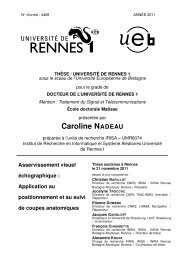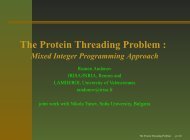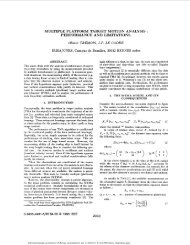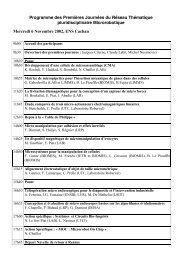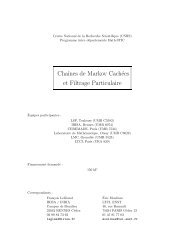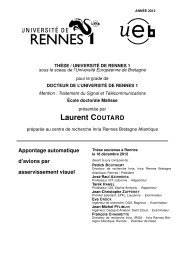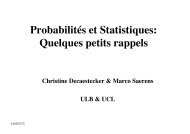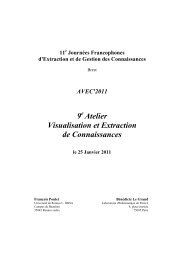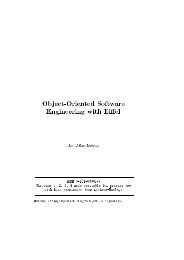Create successful ePaper yourself
Turn your PDF publications into a flip-book with our unique Google optimized e-Paper software.
Projet d’ARC INRIA 2011-2012<br />
MENEUR<br />
Modélisation en Economie des réseaux et NEUtRalité du<br />
Net<br />
Network Economics and Net Neutrality Model<strong>in</strong>g<br />
EPI INRIA :<br />
Dionysos, Maestro, Mescal and P. Bernhard<br />
Other academic partners:<br />
Telecom Bretagne, FTW, Columbia University, Pennsylvania State University<br />
Industrial partners:<br />
Alcatel-Lucent Bell Labs, Orange Labs<br />
Leader: Bruno Tuff<strong>in</strong> (Dionysos)<br />
Abstract<br />
The goal of this project is to study the <strong>in</strong>terest of network neutrality, a topic that<br />
has recently ga<strong>in</strong>ed a lot of attention. The project aims at elaborat<strong>in</strong>g mathematical<br />
models that will be analyzed to <strong>in</strong>vestigate its impact on users, on social welfare and<br />
on providers’ <strong>in</strong>vestment <strong>in</strong>centives, among others, and eventually propose how (and<br />
if) network neutrality should be implemented. It br<strong>in</strong>gs together experts from different<br />
scientific fields, telecommunications, applied mathematics, economics, mix<strong>in</strong>g academy<br />
and <strong>in</strong>dustry, to discuss those issues. It is a first step towards the elaboration of a<br />
European project.<br />
Contents<br />
1 Participants 3<br />
1.1 EPI Dionysos . . . . . . . . . . . . . . . . . . . . . . . . . . . . . . . . . . . . 3<br />
1.2 EPI Maestro . . . . . . . . . . . . . . . . . . . . . . . . . . . . . . . . . . . . 3<br />
1.3 EPI Mescal . . . . . . . . . . . . . . . . . . . . . . . . . . . . . . . . . . . . . 3<br />
1.4 Pierre Bernhard (DR INRIA, member of EPI Comore) . . . . . . . . . . . . . 4<br />
1.5 GET/Telecom Bretagne . . . . . . . . . . . . . . . . . . . . . . . . . . . . . . 4<br />
1.6 FTW, Vienna . . . . . . . . . . . . . . . . . . . . . . . . . . . . . . . . . . . . 4<br />
1
1.7 Columbia University, USA . . . . . . . . . . . . . . . . . . . . . . . . . . . . . 4<br />
1.8 Pennsylvania State University, USA . . . . . . . . . . . . . . . . . . . . . . . 5<br />
1.9 Alcatel-Lucent Bell Labs France, Semantic and Autonomous Technologies<br />
(SAT) department . . . . . . . . . . . . . . . . . . . . . . . . . . . . . . . . . 5<br />
1.10 Orange Labs . . . . . . . . . . . . . . . . . . . . . . . . . . . . . . . . . . . . 5<br />
2 Scientific goals 5<br />
2.1 Context . . . . . . . . . . . . . . . . . . . . . . . . . . . . . . . . . . . . . . . 5<br />
2.2 Description of activities and respective goals of participants . . . . . . . . . . 7<br />
2.2.1 What should be a good def<strong>in</strong>ition/implementation of network neutrality? 7<br />
2.2.2 Who br<strong>in</strong>gs the most added-value, and who should pay the other <strong>in</strong> a<br />
non-neutral network? . . . . . . . . . . . . . . . . . . . . . . . . . . . 8<br />
2.2.3 What is the impact of neutrality on network <strong>in</strong>vestments? . . . . . . . 8<br />
2.2.4 What is the impact of non-neutrality on (content) <strong>in</strong>novation? . . . . 9<br />
2.2.5 Shall we (at least) allow service differentiation? . . . . . . . . . . . . . 9<br />
2.3 Expected results . . . . . . . . . . . . . . . . . . . . . . . . . . . . . . . . . . 9<br />
2.4 State of the art and position<strong>in</strong>g . . . . . . . . . . . . . . . . . . . . . . . . . . 10<br />
3 F<strong>in</strong>ancial appendix 11<br />
2
1 Participants<br />
1.1 EPI Dionysos<br />
Involved : Bruno Tuff<strong>in</strong> (CR INRIA), Hai Tran Hoang (PhD student), Jean-Marc Vigne<br />
(PhD student).<br />
Dionysos is a group work<strong>in</strong>g on the identification, the conception and the selection of the<br />
most appropriate network architectures of a communication service. Dionysos has acquired<br />
an expertise <strong>in</strong> the area of telecommunication networks pric<strong>in</strong>g, a topic on which the group<br />
has been deeply <strong>in</strong>volved for the past eight years, participat<strong>in</strong>g <strong>in</strong> (or lead<strong>in</strong>g) many projects<br />
at the French and European levels. We can especially remark that the group is currenty<br />
lead<strong>in</strong>g an ANR project on (economic) competition among providers (see http://captures.<br />
<strong>in</strong>ria.fr and, among references, [12, 13]), a problem for which network neutrality is a new<br />
key component.<br />
The group will br<strong>in</strong>g this expertise on the mathematical model<strong>in</strong>g of pric<strong>in</strong>g schemes<br />
and of competition among providers.<br />
1.2 EPI Maestro<br />
Involved : Eitan Altman (DR INRIA), S. Wong (PhD Student <strong>in</strong> Law).<br />
Maestro is a group work<strong>in</strong>g on methods and tools for the performance evaluation, optimization<br />
and control of networks. The people <strong>in</strong>volved <strong>in</strong> the project are more specifically<br />
<strong>in</strong>ternational actors <strong>in</strong> the theory and application of game theory <strong>in</strong> telecommunication networks.<br />
The group will therefore br<strong>in</strong>g this expertise to the project, game theory be<strong>in</strong>g the<br />
fundamental tool to analyze the <strong>in</strong>teractions between the economic players depend<strong>in</strong>g on<br />
whether network neutrality is or is not applied.<br />
Note that network neutrality is an important part of a new topic <strong>in</strong> Maestro named<br />
“Access to knowledge and culture: The <strong>in</strong>terplay between legislation, Economics and <strong>in</strong>formation<br />
technology” led by Eitan Altman for two years (see http://www-sop.<strong>in</strong>ria.fr/<br />
members/Eitan.Altman/accessF.html).<br />
S. Wong will br<strong>in</strong>g her knowledge on the law aspect to the project.<br />
1.3 EPI Mescal<br />
Involved: Bruno Gaujal (DR INRIA), Cor<strong>in</strong>ne Touati (CR INRIA)<br />
Mescal is a group work<strong>in</strong>g on the efficient design of large scale distributed systems.<br />
Mescal has been <strong>in</strong>vestigat<strong>in</strong>g the establishment of virtual prices, also called shadow prices<br />
<strong>in</strong> congestion networks. These prices ensure a rational use of resources. Equilibria can also<br />
be improved by advis<strong>in</strong>g policies to mobiles such that any user that does not follow these<br />
pieces of advice will necessarily penalize herself (correlated equilibria). Mescal members<br />
are lead<strong>in</strong>g the selfnets action de recherche with<strong>in</strong> the jo<strong>in</strong>t laboratory between INRIA and<br />
Alcatel-Lucent on self-optimiz<strong>in</strong>g networks. In this ARC project, Mescal members will especially<br />
focus on non-symmetrical price problems and the algorithmic issues (synchronization,<br />
available <strong>in</strong>formation, time and memory complexity).<br />
3
1.4 Pierre Bernhard (DR INRIA, member of EPI Comore)<br />
Pierre Bernhard br<strong>in</strong>gs his expertise <strong>in</strong> game theory, and more specifically <strong>in</strong> dynamic games,<br />
Wardrop equilibria, E.S.S. and evolutionary games.<br />
Pierre Bernhard will <strong>in</strong>tervene <strong>in</strong> the project at a personal level (as an Emeritus DR<br />
INRIA), s<strong>in</strong>ce his EPI INRIA Comore does not work on telecommunications.<br />
1.5 GET/Telecom Bretagne<br />
Involved : Patrick Maillé (MdC).<br />
The member of this eng<strong>in</strong>eer<strong>in</strong>g school has developed an expertise <strong>in</strong> the doma<strong>in</strong> of<br />
network pric<strong>in</strong>g and game theory s<strong>in</strong>ce 2002. He has also spent 6 months <strong>in</strong> 2006 at the<br />
Columbia Bus<strong>in</strong>ess School (Columbia University, New York, USA) to work with Nicolas<br />
Stier-Moses, who has also recently started an activity on network neutrality <strong>in</strong> the USA.<br />
Patrick Maillé is also a member of ANR Captures project <strong>in</strong>terested <strong>in</strong> this topic, and will<br />
help for the discussion and collaboration with Columbia University.<br />
1.6 FTW, Vienna<br />
Involved : Peter Reichl, Ivan Gojmerac (key researchers).<br />
FTW (Forschungszentrum Telekommunikation Wien) is a Telecommunications Research<br />
Center <strong>in</strong> Vienna, funded half by the government and half by Industry. The participants <strong>in</strong><br />
MENEUR project are key researchers <strong>in</strong> this <strong>in</strong>stitute work<strong>in</strong>g on future telecommunication<br />
ecosystems (an ecosystem is def<strong>in</strong>ed as a community of organisms together with their environment,<br />
viewed as a system of <strong>in</strong>teractions and <strong>in</strong>terdependent relationships). The network<br />
neutrality issue is at the heart of telecommunication ecosystems.<br />
FTW will br<strong>in</strong>g to the project the po<strong>in</strong>t of view of another European country, their<br />
knowledge on the feasibility from the technological po<strong>in</strong>t of view, as well as of a European<br />
operator as consultants for Telecom Austria.<br />
1.7 Columbia University, USA<br />
Nicolas Stier-Moses (Associate Professor)<br />
Professor Stier’s research focuses on the study of the impact that self-m<strong>in</strong>ded agents have<br />
on decentralized systems. In particular, his goal is to explore mechanisms that can help align<br />
the <strong>in</strong>centive of agents and result <strong>in</strong> efficient outcomes. He is tra<strong>in</strong>ed as a mathematician,<br />
computer scientist and operations researcher, and has s<strong>in</strong>ce specialized <strong>in</strong> game theoretic<br />
models. He developed a strong <strong>in</strong>terest <strong>in</strong> telecommunication networks s<strong>in</strong>ce his first visit<br />
to INRIA Rennes <strong>in</strong> 1998. After that, he visited INRIA multiples times and cont<strong>in</strong>ued to do<br />
research <strong>in</strong> this application doma<strong>in</strong>. Recently, he wrote a number of research and outreach<br />
articles about network neutrality to highlight how consider<strong>in</strong>g <strong>in</strong>vestment decisions and<br />
competition might <strong>in</strong>fluence the choice of policy.<br />
This collaboration will br<strong>in</strong>g the North-American po<strong>in</strong>t of view to the project.<br />
4
1.8 Pennsylvania State University, USA<br />
George Kesidis (Full Professor)<br />
Professor Kesidis’ research is about model<strong>in</strong>g and performance evaluation of communication<br />
and computer network<strong>in</strong>g mechanisms, schedul<strong>in</strong>g and rout<strong>in</strong>g, Internet security and<br />
more importantly for the project, network economics and games. He has already started<br />
an activity around network neutrality and <strong>in</strong>itiated a collaboration on this issue with EPI<br />
Maestro as illustrated by publication [2]. He will also br<strong>in</strong>g the North-American po<strong>in</strong>t of<br />
view to the project.<br />
1.9 Alcatel-Lucent Bell Labs France, Semantic and Autonomous<br />
Technologies (SAT) department<br />
Hélia Pouyllau (Research Eng<strong>in</strong>eer)<br />
The SAT department of Alcatel-Lucent Bell France focuses on issues <strong>in</strong> carrier-grade<br />
network<strong>in</strong>g, tackl<strong>in</strong>g 3 topics of research: network as a service (NaaS), self-* management<br />
and traffic-aware rout<strong>in</strong>g. The NaaS research activity regroups problematic on metro network<br />
issues, deliver<strong>in</strong>g QoS across networks and Internet evolutions. The SAT department<br />
leads the European Project ETICS on economic and technical problems <strong>in</strong> <strong>in</strong>ter-carrier service<br />
delivery. In the past, they also participated to the French ANR ACTRICE and have<br />
published several papers address<strong>in</strong>g both economic and technical dimensions of the topic.<br />
ALBLF will br<strong>in</strong>g its expertise on Internet economics and network <strong>in</strong>terconnection architectures<br />
<strong>in</strong> order to validate the models and solutions proposed by the partners.<br />
1.10 Orange Labs<br />
Orange Labs will br<strong>in</strong>g the po<strong>in</strong>t of view of an operator to the project.<br />
2 Scientific goals<br />
2.1 Context<br />
In the current Internet bus<strong>in</strong>ess model, Internet Service Providers (ISPs) charge both endusers<br />
and content providers directly connected to them. ISPs generally have public peer<strong>in</strong>g or<br />
transit (i.e. customer-provider relation) agreements among them but do not charge content<br />
providers that are associated with other ISPs. These agreements structure the Internet <strong>in</strong> a<br />
Tiers architecture at the top of which “Tier 1” operators dom<strong>in</strong>ate the market. Nevertheless,<br />
there is now an <strong>in</strong>creas<strong>in</strong>g traffic asymmetry between ISPs, ma<strong>in</strong>ly due to some prom<strong>in</strong>ent<br />
and resource consum<strong>in</strong>g content providers. The typical example is YouTube (owned by<br />
Google), accessed by all users while hosted by a s<strong>in</strong>gle Tier 1 ISP, whose traffic constitutes<br />
now a non-negligible part of the whole Internet traffic. This issue has been the start<strong>in</strong>g<br />
po<strong>in</strong>t of the debate launched at the end of 2005, by Ed Whitacre (CEO of AT&T) say<strong>in</strong>g<br />
that content providers should be charged by ISPs they are not directly connected to:<br />
How do you th<strong>in</strong>k they’re go<strong>in</strong>g to get to customers? Through a broadband pipe.<br />
Cable companies have them. We have them. Now what they would like to do is<br />
use my pipes free, but I a<strong>in</strong>’t go<strong>in</strong>g to let them do that because we have spent this<br />
5
capital and we have to have a return on it. So there’s go<strong>in</strong>g to have to be some<br />
mechanism for these people who use these pipes to pay for the portion they’re<br />
us<strong>in</strong>g. Why should they be allowed to use my pipes? The Internet can’t be free<br />
<strong>in</strong> that sense, because we and the cable companies have made an <strong>in</strong>vestment and<br />
for a Google or Yahoo! or Vonage or anybody to expect to use these pipes [for]<br />
free is nuts.<br />
The underly<strong>in</strong>g concern is that <strong>in</strong>vestment is made by ISPs but content providers have<br />
an important part of the dividends. The revenue aris<strong>in</strong>g from onl<strong>in</strong>e advertis<strong>in</strong>g (mean<strong>in</strong>g<br />
show<strong>in</strong>g graphical ads on regular web pages) is estimated at approximately a $24 billion<br />
<strong>in</strong> 2009 [6] while textual ads on search pages has led to a comb<strong>in</strong>ed revenue $8.5 billion <strong>in</strong><br />
2007 [9], those figures <strong>in</strong>creas<strong>in</strong>g every year. Meanwhile, transit prices - which constitutes<br />
the ma<strong>in</strong> source of revenues for transit ISPs - are decreas<strong>in</strong>g and predicted to be under 1$<br />
per Mbps by 2014. ISPs argue that there is no sufficient <strong>in</strong>centive for them to cont<strong>in</strong>ue to<br />
<strong>in</strong>vest on the network <strong>in</strong>frastructures if most benefits come to content providers.<br />
Another option, if no charg<strong>in</strong>g to content providers is implemented by ISPs, is to lower<br />
the quality of the traffic com<strong>in</strong>g from distant content providers. As an illustration, this has<br />
been the topic of a new controversy <strong>in</strong> 2007 when Comcast, a ma<strong>in</strong> ISP <strong>in</strong> the USA, started<br />
(as an extreme case) block<strong>in</strong>g P2P applications such as BitTorrent, us<strong>in</strong>g the argument that<br />
P2P is mostly used to share illegal content. Advocates of neutrality argued here that P2P<br />
has legitimate uses and other types of <strong>in</strong>itiatives should be imag<strong>in</strong>ed.<br />
In both cases, the goal of ISPs is to change the current behavior of the Internet, where<br />
all users (of whatever type) have a full access to the network with the same quality at a<br />
flat-rate fee.<br />
This has led to a lot of protests from content providers and user associations argu<strong>in</strong>g<br />
that charg<strong>in</strong>g for content or block<strong>in</strong>g types of flow is an imp<strong>in</strong>gement of freedom of speech<br />
[17] and/or human rights that will impact the network development. We want to <strong>in</strong>vestigate<br />
the relevance of arguments from both sides and see if service differentiation should<br />
be allowed, and if yes, at which level and how far they should be implemented. This issue<br />
has already been a subject of debate at the law and policy makers level. In the US the<br />
trend was first to go with impos<strong>in</strong>g network regulation on ISPs to ensure neutrality, but it<br />
is not clear who, if any, has the authority to regulate the Internet (for <strong>in</strong>stance the Federal<br />
Communications Commission (FCC) lost a lawsuit where the supreme court found that they<br />
lack the authority). The Federal Trade Commission (FTC) released <strong>in</strong> 2007 a report not<br />
support<strong>in</strong>g neutrality constra<strong>in</strong>ts, <strong>in</strong>creas<strong>in</strong>g the debate at the political level. This debate<br />
is also active <strong>in</strong> Europe and <strong>in</strong> France, as illustrated by the open consultation on network<br />
neutrality launched <strong>in</strong> 2010. In its response to the consultation, the French regulation authority,<br />
ARCEP, has published a proposal <strong>in</strong>tend<strong>in</strong>g to def<strong>in</strong>e how net neutrality could be<br />
implemented. Among these proposals, some of them catch our attention: i) ISPs should<br />
respect the neutrality between applications but should be let free to operate <strong>in</strong> an efficient<br />
manner their network, ii) the efficient management of a network should be made at the<br />
detriment of best-effort services, and iii) <strong>in</strong>terconnection contracts should be more transparent.<br />
This latter is a clear reference to the emergence of private peer<strong>in</strong>g agreements which<br />
are constitut<strong>in</strong>g some k<strong>in</strong>d of private routes with<strong>in</strong> the Internet and might led to create a<br />
parallel “premium“ Internet.<br />
Network neutrality also br<strong>in</strong>gs some questions at the technological level, highlight<strong>in</strong>g the<br />
multidiscipl<strong>in</strong>ary aspect of the issue. Service differentiation has <strong>in</strong>deed been the subject of a<br />
vast literature <strong>in</strong> the last decade to cope with the congestion encountered <strong>in</strong> access networks,<br />
<strong>in</strong> wireless ones for <strong>in</strong>stance, but not only. This has led to the proposition of architectures<br />
such as DiffServ (for Differentiation of Service) that discrim<strong>in</strong>ate packets accord<strong>in</strong>g to the<br />
6
type of application they are associated with. The pr<strong>in</strong>ciple is that some applications may<br />
accomodate a worse quality of service <strong>in</strong> terms of delay, loss or other characteristics, and<br />
this could be used towards a better experienced overall service. Network neutrality therefore<br />
br<strong>in</strong>gs the question about whether or not this type of differentiation at the application<br />
type level, not between content providers, should be applied. There is <strong>in</strong>deed a difference<br />
between user (and/or content providers) discrim<strong>in</strong>ation and service differentiation that network<br />
neutrality issue is rais<strong>in</strong>g. The notion of “fair” discrim<strong>in</strong>ation, between applications<br />
and/or between users is subject to controversy.<br />
The project is a follow-up to the response from INRIA researchers to the french consultation<br />
on network neutrality [1] where they have exposed their ideas and posed the questions<br />
that constitute <strong>in</strong> most part this proposal.<br />
2.2 Description of activities and respective goals of participants<br />
The goal of this ARC proposal is to model the economic relationships between end-users,<br />
ISPs and content providers, and analyze the impact of non-neutrality versus neutrality.<br />
The entire debate has raised a number of unanswered questions. The ma<strong>in</strong> (but nonexhaustive<br />
list of) questions we aim at answer<strong>in</strong>g are described below. The complementarity<br />
of the groups <strong>in</strong>volved <strong>in</strong> the project, <strong>in</strong> terms of technological, economical, legal and mathematical<br />
knowledge will foster the discussions on the models and their analysis. In all cases,<br />
the models will be solved via game-theoretic tools that capture the <strong>in</strong>teractions between<br />
different actors.<br />
2.2.1 What should be a good def<strong>in</strong>ition/implementation of network neutrality?<br />
There is no very clear view of what network neutrality is. Our goal <strong>in</strong> this part would be to<br />
br<strong>in</strong>g an acceptable def<strong>in</strong>ition that will be validated by our models <strong>in</strong> terms of social welfare<br />
(social welfare measur<strong>in</strong>g the total level of satisfactions of all actors, ISPs, content providers<br />
and end-users). In other words, we will study the impact of various def<strong>in</strong>itions of neutrality<br />
on social welfare and other objective functions, and consider a satisfactory one at this level.<br />
The po<strong>in</strong>t of views of all partners from different fields (mathematics, telecommunications,<br />
economics, law) and with different perspectives (academic, ISP, content provider or network<br />
architects) will be confronted here.<br />
To give a broader idea of the issue, a network is often said to be weakly neutral if it<br />
prohibits user discrim<strong>in</strong>ation, which means it does not charge users differently for the same<br />
service. It is said to be strongly neutral if <strong>in</strong> addition it prohibits service differentiation,<br />
that is if it does not allow to manage packets differently. In a strongly neutral network,<br />
an architecture such as DiffServ could not be implemented. What if subscribers do choose<br />
among different classes of priority of service: does it br<strong>in</strong>g a real neutrality issue then? What<br />
would be the best vision of a network <strong>in</strong> terms of social welfare or <strong>in</strong> terms of user welfare<br />
is still an open question that will be discussed. The legal aspect is also important here and<br />
needs to be discussed; <strong>in</strong>deed, s<strong>in</strong>ce P2P BitTorrent (for <strong>in</strong>stance, even if its proportion of<br />
the total traffic is decl<strong>in</strong><strong>in</strong>g) and stream<strong>in</strong>g video (the <strong>in</strong>creas<strong>in</strong>g part) generate huge data<br />
volumes of illegal (copyrighted) material, ISPs cannot be blamed for facilitat<strong>in</strong>g theft if<br />
neutrality is kept <strong>in</strong> its current form.<br />
7
2.2.2 Who br<strong>in</strong>gs the most added-value, and who should pay the other <strong>in</strong> a<br />
non-neutral network?<br />
The issue of network neutrality has come up because ISPs claimed that it acts as a dis<strong>in</strong>centive<br />
for <strong>in</strong>vestment and capacity expansion of their networks. The validity of this argument<br />
has to be verified. For <strong>in</strong>stance, <strong>in</strong> [4], the authors studied this argument and came to<br />
the conclusion that, under net neutrality, ISPs <strong>in</strong>vest to reach a social optimal level, while<br />
they tend to under/over-<strong>in</strong>vest when neutrality is dropped. In their sett<strong>in</strong>g, ISPs stand<br />
as w<strong>in</strong>ners while content providers (CPs) are left <strong>in</strong> a worse position, and users who pay<br />
the ISPs for preferential treatment are better off while other consumers have a significantly<br />
worse service. ISPs often justify charg<strong>in</strong>g CPs by quantify<strong>in</strong>g the large amount of network<br />
resources “big” content providers use. On the other hand, the content a CP offers does<br />
contribute to the demand for Internet access, and thus benefits the access providers. This<br />
aspect is not considered <strong>in</strong> the ISPs’ claim. For <strong>in</strong>stance, some customers subscribe to ISPs<br />
because they want to have access to CPs such as YouTube, Amazon or facebook; this has to<br />
be taken <strong>in</strong>to account. Some references have already advocated the use of the Shapley value<br />
as a fair way to share profits between the providers, see, e.g., [10, 11]. The Shapley value<br />
is such that each provider (CP or ISP) will receive a share of the revenue proportional to<br />
its contribution to the total revenue and barga<strong>in</strong><strong>in</strong>g power. One of the ma<strong>in</strong> benefits of this<br />
approach is that it yields Pareto optimality for all players, and requires <strong>in</strong> particular that<br />
CPs, many of whom receive third-party <strong>in</strong>come such as advertis<strong>in</strong>g revenue from consumers’<br />
demand, help pay for the network access that makes this new <strong>in</strong>come possible.<br />
All the models studied for now are nevertheless quite simple and need to be made closer<br />
to reality. We expect to represent all actors <strong>in</strong> a model:<br />
• End-users who decide which ISP to be associated with depend<strong>in</strong>g on access price, QoS<br />
level (which depends itself on the number of customers) and choice of CPs they can<br />
reach;<br />
• (Competitive) CPs mak<strong>in</strong>g money thanks to advertis<strong>in</strong>g (the more end-users that visit,<br />
the larger the revenue) and pay an access price to a provider they are connected to<br />
(the choice of this provider could be considered fixed or a decision possibility, typically<br />
chosen as the one maximiz<strong>in</strong>g the CP revenue).<br />
• Competitive ISPs who offer a given capacity and propose an access price to end-users<br />
and directly connected CPs, and/or a transit price to other ISPs. Demand will spread<br />
among providers accord<strong>in</strong>g to those offers and the CPs that are reachable.<br />
Those assumptions illustrate the <strong>in</strong>terdependences of strategies among all players. We will<br />
study the model <strong>in</strong> the neutral case as presented just above and compare the results with<br />
those <strong>in</strong> the non-neutral situation where ISPs are <strong>in</strong> addition allowed to charge distant CPs,<br />
but those CPs are entitled to refuse to be connected to that ISP. In that case, the ISPs take<br />
the risk of los<strong>in</strong>g some customers to competitors which have made that connection.<br />
We will compare the Shapley value of ISPs and CPs to <strong>in</strong>vestigate whether this claim<br />
that value is brought by ISPs is true or not (note that we do not assume cooperation here,<br />
the Shapley value com<strong>in</strong>g from cooperative game theory, but we just want to compute the<br />
share if revenue that can be assigned to come from each party).<br />
2.2.3 What is the impact of neutrality on network <strong>in</strong>vestments?<br />
The question of dis<strong>in</strong>centive for ISPs to <strong>in</strong>vest <strong>in</strong> network technologies and <strong>in</strong>frastructures<br />
on a long term, as brought by opponents of network neutrality, is also worth be<strong>in</strong>g studied<br />
deeper.<br />
8
A way to tackle this problem is to consider a repeated version with <strong>in</strong>f<strong>in</strong>ite horizon of the<br />
above game where ISPs also have the possibility to <strong>in</strong>vest on technologies and capacities.<br />
Here too, a comparison between the neutral and the non-neutral cases will give an answer<br />
to the question.<br />
If neutrality has an impact on <strong>in</strong>vestment, one could imag<strong>in</strong>e <strong>in</strong>troduc<strong>in</strong>g rules to enforce<br />
ISPs to <strong>in</strong>vest a part of their revenues <strong>in</strong> the <strong>in</strong>frastructure. This could typically be implemented<br />
when sell<strong>in</strong>g licences <strong>in</strong> the wireless context. Remark that this regulatory rule can<br />
be supported by the article 3.1 of the directive 2002/22/CE (<strong>in</strong> french): “Les Etats Membres<br />
veillent à ce que les services énumérés dans le présent chapitre soient mis à la disposition de<br />
tous les utilisateurs f<strong>in</strong>als sur leur territoire, <strong>in</strong>dépendamment de leur position géographique,<br />
au niveau de qualité spécifié et, compte tenu de circonstances nationales particulières, à un<br />
prix abordable”. This would also deserve to be analyzed.<br />
2.2.4 What is the impact of non-neutrality on (content) <strong>in</strong>novation?<br />
Another common idea, brought by the advocates of network neutrality this time, is that<br />
non-neutrality will prevent <strong>in</strong>novation, entrepreneurship and <strong>in</strong>vestment at the content level<br />
[5]. Indeed, it is often argued that Google, facebook or Twitter, among others, might not<br />
have developed <strong>in</strong> the case of a non-neutral network if they would have to pay the distant<br />
ISPs at the beg<strong>in</strong>n<strong>in</strong>g of their bus<strong>in</strong>ess, and that many new services would be prevented<br />
from appear<strong>in</strong>g due to these additional costs, at the expense of the whole system future<br />
value. This claim has to be verified. We want to model <strong>in</strong>novation (<strong>in</strong> terms of content) as<br />
a function of costs and <strong>in</strong>vestigate if there is a threshold over which non-neutrality would<br />
curb the development of the network and if it would eventually also <strong>in</strong>duce losses for the<br />
ISPs also. The <strong>in</strong>vestment stage (which can be understood as choos<strong>in</strong>g the quality of the<br />
content provider) has rarely been modeled explicitly, specially <strong>in</strong> a sett<strong>in</strong>g where ISPs also<br />
select quality and <strong>in</strong>vestment.<br />
2.2.5 Shall we (at least) allow service differentiation?<br />
While all the above questions deal with the IPSs charg<strong>in</strong>g CPs for the traffic they send<br />
on their network, we would like to address the <strong>in</strong>terest of weak neutrality be<strong>in</strong>g acceptable<br />
or not, by allow<strong>in</strong>g service differentiation <strong>in</strong> case of congestion to allow a better perceived<br />
QoS, but without differentiation based on CP or end-user identity. Includ<strong>in</strong>g the <strong>in</strong>duced<br />
management costs <strong>in</strong> the previous models, we will compare the results on social welfare, user<br />
welfare, <strong>in</strong>novation with respect to a fully neutral network. But the decision of implement<strong>in</strong>g<br />
service differentiation be<strong>in</strong>g at the appreciation of the ISP, this will depend on the result<strong>in</strong>g<br />
potential revenue <strong>in</strong>crease.<br />
A related issue is about migrat<strong>in</strong>g from the pure flat-rate pric<strong>in</strong>g to a scheme where the<br />
real value of the service could be taken <strong>in</strong>to account, and how to implement it smoothly.<br />
Indeed, chang<strong>in</strong>g for <strong>in</strong>stance to a volume-based pric<strong>in</strong>g of flows may solve problems of<br />
security, <strong>in</strong>tellectual property protections of content, and (potential) under-fund<strong>in</strong>g growth<br />
<strong>in</strong> network <strong>in</strong>frastructure [7]. The impact on the network neutrality and entrepreneurship<br />
aspects can be studied.<br />
2.3 Expected results<br />
The objective of this project is to study the validity and <strong>in</strong>terest of network neutrality<br />
and to answer the above questions thanks to mathematical models. This will give useful<br />
<strong>in</strong>formation to a policy maker before tak<strong>in</strong>g strategical decisions.<br />
9
Legislation on Network Neutrality will shape the future Internet, and will thus have an<br />
enormous impact on its nature. The Internet is expected to centralize around 30% of the<br />
French economic activity <strong>in</strong> the com<strong>in</strong>g years, and hence its evolution is a central strategic<br />
aspect <strong>in</strong> French economy.<br />
This ARC has as ma<strong>in</strong> objective to ensure that French experts <strong>in</strong> the French academia<br />
and research <strong>in</strong>stitutes will be aware of the issues that are be<strong>in</strong>g decided and would be<br />
able to contribute to this debate. We should mention that <strong>in</strong> parallel to the French public<br />
consultation on network neutrality, that was launched by the government on April 2010, the<br />
French telecom regulation authority, ARCEP, organized an International workshop on this<br />
issue with representatives of all economic actors <strong>in</strong>clud<strong>in</strong>g Academia. Not one representative<br />
from the Academia came from France.<br />
We are aware that the topic of Net Neutrality is a complex one s<strong>in</strong>ce it <strong>in</strong>volves both<br />
technological aspects as well as economics and law. We therefore have as a secondary<br />
objective to create an <strong>in</strong>terdiscipl<strong>in</strong>ary active group that <strong>in</strong>volves experts <strong>in</strong> network<strong>in</strong>g,<br />
economics and law that would study and analyze the current issues that concern the future<br />
Internet. Moreover, <strong>in</strong> order to understand the impact on French economy, our group will<br />
<strong>in</strong>clude researchers from <strong>in</strong>dustry. Typically, a goal is, hopefully <strong>in</strong> the first year of the<br />
project (due to the very hot nature of network neutrality), to set up a European project<br />
on this issue, aris<strong>in</strong>g from the <strong>in</strong>itial discussions with<strong>in</strong> the group, and with<strong>in</strong> INRIA an<br />
“Action d’Evergure” on this broader aspect of Network Economics, a topic which could be<br />
highlighted more <strong>in</strong> the <strong>in</strong>stitute.<br />
2.4 State of the art and position<strong>in</strong>g<br />
The response from the INRIA researchers to the French consultation [1] was not the only<br />
one; we can mention among others the response from the regulation authority ARCEP [3].<br />
A summary of public consultations can be found <strong>in</strong> [19].<br />
Network neutrality analysis has attracted a lot of attention recently. The reader can<br />
for <strong>in</strong>stance go to http://www.ssrn.com/ and check the number of publications associated<br />
with keyword “Network Neutrality” (184 on October 5) or the book [8]. Tim Wu (Columbia<br />
University) is considered as the <strong>in</strong>ventor of the expression “Network Neutrality”; his web<br />
page http://timwu.org/network_neutrality.html conta<strong>in</strong>s useful <strong>in</strong>formations and def<strong>in</strong>itions.<br />
There exist several projects on this theme. We have identified<br />
• Network Neutrality Squad (http://www.nnsquad.org/) is an open-membership, opensource<br />
effort, project that aims at keep<strong>in</strong>g Internet “fair”, by foster<strong>in</strong>g discussion on<br />
detection, analysis, and <strong>in</strong>cident report<strong>in</strong>g of any anticompetitive, discrim<strong>in</strong>atory, or<br />
other restrictive actions from ISPs. This project is a network<strong>in</strong>g-oriented, and explictly<br />
favors neutrality.<br />
• Dynamic platform Standards Project for Real Network Neutrality (http://www.dpsproject.<br />
com/) is also a project lobby<strong>in</strong>g for neutrality.<br />
• Media Access Project http://www.mediaaccess.org/ is a non-profit law firm and<br />
advocacy organization promot<strong>in</strong>g freedom of speech. They have a special section on<br />
network neutrality.<br />
• GTNOISE Network Access Neutrality Project at Georgia Tech (http://www.gtnoise.<br />
net/nano/) develops a monitor<strong>in</strong>g tool to identify performance degradations due to<br />
network neutrality violation by ISPs.<br />
10
But all those projects are user or technological projects typically defend<strong>in</strong>g neutrality. Our<br />
goal is rather to study neutrality from the mathematical model<strong>in</strong>g and analysis po<strong>in</strong>t of view.<br />
Among the most prom<strong>in</strong>ent groups work<strong>in</strong>g on this last specific po<strong>in</strong>t, we can mention:<br />
• In the USA:<br />
– (N. Stier and G. We<strong>in</strong>traub (Columbia University) with P. Njoroge and A. Ozdaglar<br />
(MIT) have started a similar work on network neutrality model<strong>in</strong>g and analysis<br />
[16]. In the prelim<strong>in</strong>ary work, they have used game theory to create a model that<br />
mimics a two-sided market for Internet access with at one side ISPs receiv<strong>in</strong>g<br />
payment streams from consumers and CPs, so that platforms compete for consumer<br />
and CP fees, and at the other side, CPs. N. Stier (a former collaborator<br />
of several EPI INRIA, among which Dionysos) is part of our proposal to br<strong>in</strong>g<br />
their po<strong>in</strong>t of view.<br />
– G. Kesidis (Penn State University) is also an active member o network neutrality<br />
analysis via game theory. He is also part of the project, cooperat<strong>in</strong>g with EPI<br />
Maestro on this [2], and will also br<strong>in</strong>g the North-American aspect and po<strong>in</strong>t of<br />
view.<br />
– Another stream of works is by J. Musachio (UC Santa Cruz), G. Schwartz and J.<br />
Walrand (UC Berkeley)[15, 14] who also study how the network regime (neutral<br />
or non-neutral) affects provider <strong>in</strong>vestment <strong>in</strong>centives, network quality and user<br />
prices.<br />
– A. Odlyzko (University of M<strong>in</strong>nesota) [17] who rather analyzes the historic aspects,<br />
the price discrim<strong>in</strong>ation precedents, and the value of bits and content versus<br />
connectivity.<br />
• In Europe, basically <strong>in</strong> France:<br />
– the already mentionned and prelim<strong>in</strong>ary model<strong>in</strong>g work [2] with<strong>in</strong> INRIA;<br />
– the noticeable work of Claudia Savedraa, f<strong>in</strong>ish<strong>in</strong>g her PhD jo<strong>in</strong>tly at Orange<br />
Labs and École Polytechnique and who started to study the barga<strong>in</strong><strong>in</strong>g power<br />
between CPs and ISPs [18].<br />
• In Asia:<br />
– The work at the Ch<strong>in</strong>ese University of Hong-Kong, <strong>in</strong> collaboration with Columbia<br />
University, [10, 11] where the authors make use of cooperative game theory and<br />
Shapley value to share the revenue among actors.<br />
As can be seen, all the <strong>in</strong>itiatives we have found about the mathematical model<strong>in</strong>g<br />
aspect are quite <strong>in</strong>dividual ones. This project is to our knowledge the first that br<strong>in</strong>gs officially<br />
together academics and <strong>in</strong>dustry (network architects and providers), mix<strong>in</strong>g experts <strong>in</strong><br />
telecommunications technology, applied mathematics, law and economics on those model<strong>in</strong>g<br />
aspects.<br />
3 F<strong>in</strong>ancial appendix<br />
We estimate the necessary budget for the two years of this ARC at 73 ke (86.6 ke count<strong>in</strong>g<br />
the total cost of a post-doc). This budget can be decomposed <strong>in</strong>to the follow<strong>in</strong>g way:<br />
• Organization of a kick-off workshop followed by one day of (<strong>in</strong>ternal) bra<strong>in</strong>storm<strong>in</strong>g:<br />
12 ke<br />
11
– costs are made of participants trips and expenses for two days, and the <strong>in</strong>vitation<br />
of two <strong>in</strong>ternational experts.<br />
• Trips for bilateral or multi-lateral <strong>in</strong>ternal meet<strong>in</strong>gs over the two years: 20 ke<br />
• Organization of a f<strong>in</strong>al workshop: 10 ke<br />
– costs are made of participants trips and expenses for two days.<br />
• Recruit<strong>in</strong>g a postdoc for one year, <strong>in</strong> EPI Dionysos. 31 ke(count<strong>in</strong>g salary only; 44.6<br />
ke if talk<strong>in</strong>g about total cost).<br />
The workshops will be organized <strong>in</strong> Rennes, Paris or Sophia-Antipolis <strong>in</strong> order to m<strong>in</strong>imize<br />
the costs.<br />
The postdoc will work on the game-theoretic analysis of the models designed by the<br />
participants.<br />
References<br />
[1] E. Altman, C. Barakat, P. Bernhard, E. Fleury, P. Jacquet, A. Legout, C. Touati,<br />
B. Tuff<strong>in</strong>, and S. Wong. Réponse à la consultation sur la neutralité du net. http:<br />
//www-sop.<strong>in</strong>ria.fr/members/Eitan.Altman/DOC/conult-fr-sbm.<strong>pdf</strong>, 2010.<br />
[2] E. Altman, P. Bernhard, S. Caron, G. Kesidis, J. Rojas-Mora, and S. Wong. A study<br />
of non-neutral networks with usage-based prices. In Proceed<strong>in</strong>gs of the 3rd ETM Workshop,<br />
Amsterdam, The Netherlands, September 2010.<br />
[3] ARCEP. Neutralité de l’<strong>in</strong>ternet et des réseaux: propositions<br />
et orientations. http://www.arcep.fr/uploads/tx_gspublication/<br />
net-neutralite-orientations-sept2010.<strong>pdf</strong>, 2010.<br />
[4] H. K. Cheng, S. Bandyopadhyay, and H. Guo. The Debate on Net Neutrality: A Policy<br />
Perspective. Information Systems Research, Forthcom<strong>in</strong>g, 2008.<br />
[5] R. Frieden. Internet Packet Sniff<strong>in</strong>g and its Impact on the Network Neutrality Debate<br />
and the Balance of Power between Intellectual Property Creators and Consumers. Technical<br />
report, SSRN, 2007. http://papers.ssrn.com/sol3/papers.cfm?abstract_<br />
id=995273.<br />
[6] A. Ghosh and A. Sayedi. Expressive auctions for externalities <strong>in</strong> onl<strong>in</strong>e advertis<strong>in</strong>g. In<br />
Workshop on the World Wide Web (WWW), Raleigh, NC, USA, April 2010.<br />
[7] G. Kesidis. Congestion control alternatives for residential broadband access. In Proceed<strong>in</strong>gs<br />
of the IEEE Network Operations and Management Symposium (NOMS), pages<br />
874 –877, apr. 2010.<br />
[8] T.M. Lenard and R.J. (Eds.) May. Net Neutrality or Net Neuter<strong>in</strong>g: Should Broadband<br />
Internet Services be Regulated. Spr<strong>in</strong>ger, 2006.<br />
[9] D. Liu, J. Chen, and A.B. Wh<strong>in</strong>ston. Compet<strong>in</strong>g keyword auctions. In Proc. of 4th<br />
Workshop on Ad Auctions, Chicago, IL, USA, Jul 2008.<br />
12
[10] R.T.B. Ma, D.-M. Chiu, J.C.S. Lui, V. Misra, and D. Rubenste<strong>in</strong>. Interconnect<strong>in</strong>g<br />
eyeballs to content: A Shapley value perspective on isp peer<strong>in</strong>g and settlement. In Proceed<strong>in</strong>gs<br />
of the International Workshop on Economics of Networked Systems (NetEcon),<br />
pages 61–66, 2008.<br />
[11] R.T.B. Ma, D.-M. Chiu, J.C.S. Lui, V. Misra, and D. Rubenste<strong>in</strong>. On cooperative<br />
settlement between content, transit and eyeball <strong>in</strong>ternet service providers. In Proceed<strong>in</strong>gs<br />
of the ACM International Conference on Emerg<strong>in</strong>g Network<strong>in</strong>g EXperiments and<br />
Technologies (CoNEXT), 2008.<br />
[12] P. Maillé and B. Tuff<strong>in</strong>. Analysis of price competition <strong>in</strong> a slotted resource allocation<br />
game. In Proceed<strong>in</strong>gs of IEEE INFOCOM, April 2008.<br />
[13] P. Maillé and B. Tuff<strong>in</strong>. Price war <strong>in</strong> heterogeneous wireless networks. Computer<br />
Networks, 54(13):2281–2292, 2010.<br />
[14] J. Musacchio, G. Schwartz, and J. Walrand. A two-sided market analysis of provider<br />
<strong>in</strong>vestment <strong>in</strong>centives with an application to the net-neutrality issue. Review of Network<br />
Economics, 8(1):Article 3, 2009.<br />
[15] J. Musacchio, J. Walrand, and G. Schwartz. Network neutrality and provider <strong>in</strong>vestment<br />
<strong>in</strong>centives. In Signals, Systems and Computers, 2007. ACSSC 2007. Conference Record<br />
of the Forty-First Asilomar Conference on, pages 1437 –1444, nov. 2007.<br />
[16] P. Njoroge, A. Ozdaglar, N. Stier-Moses, and G. We<strong>in</strong>traub. Investment <strong>in</strong> two sided<br />
markets and the net neutrality debate. Technical Report DRO-2010-05, Columbia<br />
University, Decision, Risk and Operations Work<strong>in</strong>g Papers Series, 2010.<br />
[17] A. Odlyzko. Network neutrality, search neutrality, and the never-end<strong>in</strong>g conflict between<br />
efficiency and fairness <strong>in</strong> markets. Review of Network Economics, 8(1):40–60, 2009.<br />
[18] C.V. Saavedra. Barga<strong>in</strong><strong>in</strong>g power and the net neutrality debate. sites.google.com/<br />
site/claudiasaavedra/attachments/barga<strong>in</strong><strong>in</strong>g_power.<strong>pdf</strong>, 2009.<br />
[19] S. Wong, Rojas-Mora; J., and E. Altman. Public consultations on Net Neutrality 2010:<br />
USA, EU and France. Technical report, SSRN, 2010. http://papers.ssrn.com/sol3/<br />
papers.cfm?abstract_id=1684086.<br />
13



